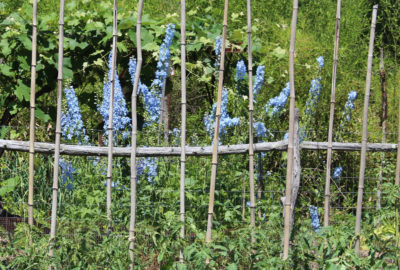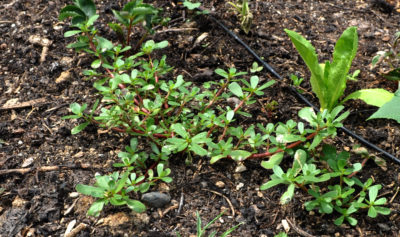GOOD SUMMER BLUES
Plan Realized
Almost two years after my plan was conceived . . . success. Looking across rows of tomatoes, corn, onions, and kale in my vegetable garden, I see tall, blue spires of delphiniums that have finally come of age.
The spires required some effort. Coarse roots of the seedlings called for an extra dose of care. Potting soil could easily fall from the roots, exposing them to drying air, as the seedlings were successfully moved to larger quarters.
And then, once seedlings were planted out just beyond the western fence of the vegetable garden, my chickens threatened them. The poultry enjoy scratching for insects near the bases of plants. Doing so weakens larger plants, even woody shrubs; doing so can kill tender young seedlings. Chicken wire laid on top of the ground let the delphinium plants grow up through the 1 inch openings while preventing chickens’ scratching.
Planning for Future Blues
The delphinium show will end any day now, especially with this hot weather. It’s hard to let go of the show — and I don’t necessarily have to. Sometimes a second, later show can be coaxed from the plants. If the stalks with spent blossoms are cut back to the bottom whorl of leaves, new flower stalks will spring forth that should bloom again later this season.
Good growing conditions help bring on this second show. That means rich soil and water, as needed. These I have provided for my delphiniums in the form of compost topped with a leafy mulch, and drip irrigation. “Good growing conditions” also means cool growing temperatures, which I cannot provide.
Even under the best of conditions, delphiniums, although perennials, are short-lived perennials. Before next spring I’ ll get some fresh seed — freshness of seed is important for good germination — and start a bevy of new plants. For the freshest seed possible, I’ll collect them from my own plants by gathering whole stalks when they are partly dry and then shaking out seeds. Planted immediately and kept slightly cool, they should sprout in a few weeks and flower next June. Sometimes they even self-sow.
Doing What Good Gardeners Do
Self-sown delphinium seedings are most welcome; not so for many other self-sowers, that is, weeds. Now is the time when many summer weeds pick up steam. Now is also the time when good gardeners and mediocre gardeners take different paths.
I want to be a good gardener so I’m planning, immediately after I dot the last word of this report, to go out and weed. My garden is generally not very weedy, mostly because I never — yes, never — till or otherwise turn over the soil. And because I snuff out small weeds with an annual mulch of compost in planting beds and wood chips in paths. (Mulching and never tilling also bring many other benefits, such as encouraging more vibrant soil life, better use of water, and, well, not having to till.)

Purslane
Still, weeds have made inroads. I can’t help but remind myself that every weed that goes to seed could self-sow to spawn myriad more of the same — for example over 50,000 seeds per pigweed plant, or almost 20,000 seeds per dandelion plant! Perennial weeds, unchecked, build up energy reserves in their roots and spread by traveling roots, as well as by self-sowing. Checking growth of these weeds now makes for a bountiful fall garden and much fewer weeds next year.
Mostly, I just bend over and pull out weeds, coaxing them out, if need be, with my hori-hori knife. Where weeds are too numerous to make one-on-one treatment too tedious, I slide my winged weeder or wire hoe along the ground to dislodge them all at once. I gather up most pulled and hoed weeds and cart them over the the compost. Sweet revenge: light-, nutrient-, and water-stealing weeds recycled into garden goodness.
Amongst the weedy interlopers are some worth separating out, for eating. Among my favorites are pigweed, which makes an excellent cooked green. And purslane, very healthful and tasty if doctored up correctly, good suggestions for which can be found in Foraging & Feasting: A Field Guide and Wild Food Cookbook by Dina Falconi and Wendy Hollender.


I have a serious patch of purslane among my winter squash and melons. In fact, it looks happier than my squash and melons! I pick it and add it to salads– it is tasty. It is a plant source of essential fatty acids, if you can believe that! Very nutritious. I have even seen recipes to pickle it (fermented, of course!) so I plan to do that soon as well.